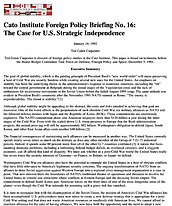Although global stability might be appealing in the abstract, the costs and risks entailed in achieving that goal are excessive. One of the worst effects is the perpetuation of such obsolete Cold War era military alliances as NATO and the bilateral defense treaties with Japan and the Republic of Korea (ROK). Those commitments are enormously expensive. The NATO commitment alone cost American taxpayers more than $120 billion a year during the latter stages of the Cold War. Even with the scaled-down U.S. troop presence in Europe that the Bush administration projects, the annual price tag will still be approximately $92 billion. Washington’s obligation to defend Japan, South Korea, and other East Asian allies costs another $40 billion.[2]
The financial consequences of maintaining such alliances can be measured in another way. The United States currently spends nearly seven times as much on the military as does any other member of the Group of 7 (G‑7) industrial powers. Indeed, it spends some 60 percent more than all of the other G‑7 countries combined.[3] A nation that faces daunting domestic problems, including a ballooning federal budget deficit, an overtaxed citizenry, and a sluggish economy, can ill-afford that kind of disparity. We must ask whether in a post-Cold War world the United States really has seven times the security interests of Germany–or France, or Britain, or Japan–to defend.
Washington’s Cold War era alliances also have the potential to entangle the United States in a host of obscure conflicts that have little relevance to America’s legitimate security concerns. The ongoing transformation of NATO from an alliance to deter Soviet aggression against Western Europe into a regional crisis management organization is a case in point. That new mission blurs the boundaries of NATO’s traditional theater of operations and threatens to involve the United States in volatile and intractable ethnic conflicts in Eastern Europe and the decaying Soviet empire. The commitment to defend South Korea puts American forces on the front lines of one of the most dangerous areas of the planet–even though the Cold War rationale for assuming such a grave risk has vanished.
It is time to recognize that with the disintegration of the Soviet Union, the mission of America’s Cold War alliances has been accomplished. U.S. policymakers must now move to create a new defense strategy that is appropriate for a post-Cold War setting and that does not waste American resources or needlessly risk American lives. We cannot afford to maintain alliances for the sake of having alliances. We now have both the opportunity and the need to adopt a new policy of strategic independence.


